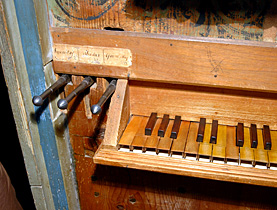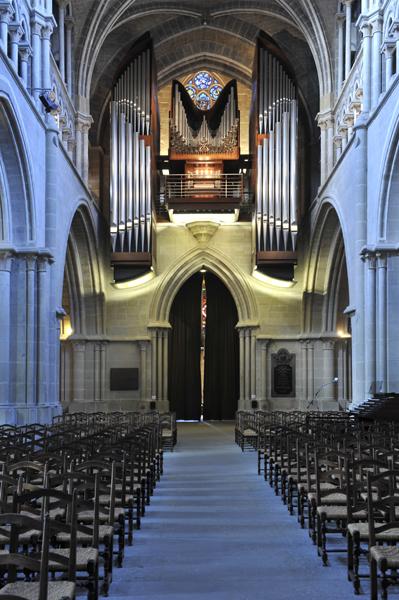A magic sound across the centuries

A modest organ in the Valère basilica in southern Switzerland claims a proud record: that of “the oldest organ in the world still in continuous use”.
Constructed around 1430, this unique instrument is the focal point of a Gothic organ festival that has been held each year for 40 years in Sion, capital of canton Valais.
Visitors lucky enough to be in the venerable church when the organist starts playing stop dead in their tracks. After a moment of uncertainty, they look up from the central nave and are surprised to discover the source of the magic.
It’s not every day that the ordinary person has the privilege of listening to a recital from an instrument which is over 550 years old. But this is a treat that can be experienced in the Valère basilica – a fortified church on a hill overlooking Sion – home to the oldest organ on the planet which is still playable.
The organ is reached up a flight of steep, narrow stairs. It turns out to be very different from its huge cousins which we are used to seeing in modern churches. It does not have a variety of keyboards or an infinite number of pedals and buttons. Just a modest, diminutive keyboard reminiscent of a simple piano.
Strictly speaking, Valère’s instrument is not the only Gothic organ in the world. Others of the period exist in other European countries.
“In fact, Spain has a number of 14th century organs but their machinery had fallen into disrepair and so it has been replaced by modern mechanisms,” Edmond Voeffray, the official organist at Sion cathedral, told swissinfo.ch.
“The organ in Valère is unique because the essential elements of its parts and mechanism were actually built in the Middle Ages. There are whole pipes that are original, which in itself is unique in the world,” he explained.
“By 1700, this organ had been modified to play baroque music. Because of this, it’s not possible to say that it sounds as it did originally but it does give us a reasonably good idea of what medieval music sounded like, which is extraordinary.”
A private concert
The organ cannot normally be visited by members of the public, but swissinfo.ch had a privileged view, and an unexpected, exclusive recital in which maestro Edmond Voeffray went through the entire history of the instrument. A real musical journey, from the Middle Ages to modern times.
Contrary to what the uninitiated might think, gothic organ music can be very cheerful and is reminiscent of folk dances. The organist began by playing the “Music for Organum Antiquum, from the Robertsbridge Codex”, compiled between 1330 and 1448 and kept at the British Museum. According to Voeffray, this is possibly the world’s oldest preserved organ music. After this he went on to Spanish baroque music and concluded with a few 19th century folk dances. There’s no doubt that the historic instrument is a box of surprises despite its small keyboard.
And how do we know that the organ dates from 1430?
“From the murals in the church”, Patrick Elsig of the Valais Museum of History explained. “We know that they were commissioned in 1435 and the same person painted the decorations on this instrument. This fact, which is well documented, allowed us to date the organ accurately”.
The wooden “hull” which looks like the prow of a ship (which you can see in the gallery accompanying this report) was added in 1630.
As Elsig explained, it should be emphasised that at that time an organ was “an almost inconceivable luxury”. This instrument would have been brought to Valère at the expense of Guillaume de Rarogne, a powerful figure who ended up as the bishop of Sion.
“The financial investment required to install an organ like this one was not inconsiderable. We mustn’t forget that the organ was the most complex machine created by human beings until the advent of the Industrial Revolution,” added Voeffray.
Ancient roots
The organ has its origins far longer back in time than the instrument in Valère, as Voeffray explained.
The first references are to an instrument conceived by a certain Ctesibios, an engineer in Alexandria in about 250 BC. But there had been instruments even before that, and there are paintings and amphorae depicting contraptions similar to an organ. One of them was known as a ‘hydraulis’ and was described by Vitrivius, who lived in the first century BC.
This instrument combined a number of pipes and a keyboard operated by a complex hydraulic system, hence its name. A modern reproduction of this device can now be seen at the Organ Museum in Roche, a few kilometres further down the Rhone valley.
“According to the ancients, the ‘hydraulis’ was impossible to explain and could only be understood by seeing it and hearing it in person”, said Voeffray.
After restoration work, completed in 1954, the Valère organ continues to delight the public thanks to the Ancient Organ Festival, which was first held in 1969. Nowadays, the event attracts the most brilliant organists and organ experts from all over the world to the town of Sion and the CDs recorded in Valère are appreciated by connoisseurs and lovers of ancient music.
Not bad for the great-great-grandfather of all the keyboards in Europe!
Rodrigo Carrizo Couto, swissinfo.ch (adapted from Spanish)
The gothic organ is regarded as the oldest instrument of its type still in working order in the world. It is thought that it was installed in Valère between 1430 and 1440.
It has barely three octaves, and the keys are much smaller than those on a modern instrument. Many of its pipes and much of its mechanism are originals from the Middle Ages.
The instrument was modified in the 16th century. It was restored in 1954, and since 1969 has been the star of the ancient organ festival in Valère. A number of recordings have been made of performances on it.
The castle, once the seat of the bishop, is built on one of the hills which dominate Sion. Together with its twin, Tourbillon, it is visible for miles.
It is both a fortress and a church, with well preserved fortifications. The church, dedicated to the Virgin, was built in stages between the beginning of the 12th century and the end of the 13th.
The castle contains not only the organ, but also the largest collection of original mediaeval furniture in Europe, dating from the 13th and 14th centuries.
A community of monks lived in the castle until the 18th century.

In compliance with the JTI standards
More: SWI swissinfo.ch certified by the Journalism Trust Initiative












You can find an overview of ongoing debates with our journalists here . Please join us!
If you want to start a conversation about a topic raised in this article or want to report factual errors, email us at english@swissinfo.ch.